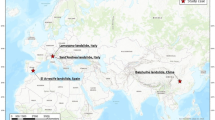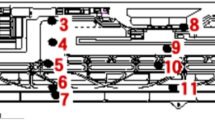Abstract
Herein, we propose a one-dimensional convolutional neural network (CNN) + long short-term memory (LSTM) model optimised by L1 regularisation and the dropout method to solve the problem of acquiring both computational speed and accuracy in a deformation prediction analysis model of a super-high arch dam’s first impoundment. The calculation results of one class (OC) + LSTM, traditional LSTM, optimised LSTM, CNN + LSTM and multilayer perceptron are compared with the actual measurement results using deformation monitoring data from the first impoundment of a super-high arch dam in southwest China. The results show that the proposed OC-LSTM model can reduce the computational time without sacrificing computational accuracy, providing a new computational model for super-high arch dam deformation prediction during the first impoundment.










Similar content being viewed by others
References
He J. Theory and application of dam safety monitoring [M]. China Water Resources and Hydropower Press, 2010.
Yang J, Wu Z (2002) Research status and development of dam safety monitoring at home and abroad. J Xi’an Univ Tech 18(1):5
Tonini D (1956) Observed behavior of several Italian arch dams. J Power Division 82(6):1134–1141
Kuai P, Jederbeike ZH et al (2015) Deformation monitoring model of super-high arch dam during construction and initial stage of impoundment. Water Conserv Sci Tech Econ 21(8):3
Hu B, Liu G, Wu Z. (2014) Analysis and safety evaluation of dam body deformation characteristics during the first impoundment period of Xiaowan super-high arch dam [C]. China Hydropower Engineering Society Dam Safety Committee and Dam Safety Monitoring Technology Status and Development Prospect Academic Exchange Conference.
Zhang G, Li H, Ai Y. Regression statistical model research on construction of super-high arch dam and initial water storage deformation [C]. China dam association; sichuan university. China dam association; Sichuan University, 2012
Shen J, Zheng D (2018) Improved spatial and temporal distribution model of arch dam deformation with temperature component. Water Resour Hydropower Tech 49(5):6
Yin W, Zhao E, Gu C et al (2019) A nonlinear method for component separation of dam effect quantities using kernel partial least squares and pseudosamples. Adv Civil Eng 2019(6):1–12
Liang G, Hu Y, Li Q. Safety monitoring of high arch dams in initial operation period using vector error correction model [J]. Rock Mechanics and Rock Engineering, 2017.
Ren Q, Li M, Li H et al (2021) A novel deep learning prediction model for concrete dam displacements using interpretable mixed attention mechanism. Adv Eng Inform 50(3):101407
Xu C, Wang S, Gu C, et al. (2022) A Probabilistic prediction model for displacement of super-high arch dams combined with spatial correlation. Journal of Wuhan University (Information Science Edition): 1–15[03–10]. https://doi.org/10.13203/j.whugis20200508.
Wang S, Xu Y, Gu C et al (2020) Two spatial association-considered mathematical models for diagnosing the long-term balanced relationship and short-term fluctuation of the deformation behaviour of high concrete arch dams. Struct Health Monit 19(5):1421–1439
Liu W, Pan J, Ren Y et al (2020) Coupling prediction model for long-term displacements of arch dams based on long short-term memory network. Struct Control Health Monit 27(3):e2548
Ren Q, Shen Y, Li M, Kong R et al (2021) Research on in-depth analysis model and optimization of safety monitoring of hydraulic structures. J Hydraul Eng 52(01):71–80. https://doi.org/10.13243/j.cnki.slxb.20200270
Yang D, Gu C, Zhu Y et al (2020) A Concrete dam deformation prediction method based on LSTM with attention mechanism. IEEE Access 8:185177–185186
Qu X, Yang J, Chang M (2019) A deep learning model for concrete dam deformation prediction based on RS-LSTM. J Sensors 2019(1):1–14
Wu Z. Safety monitoring theory of hydraulic structures and its application [M] Higher education press, 200
Gu C, Wu Z. Theory and method of dam and dam foundation safety monitoring and its application [M]. Hehai University Press, 2006.
Lsra D, Vew A, Tffb C et al (2019) A comparative analysis of long-term concrete deformation models of a buttress dam. Eng Struct 193:301–307
Ren QB, Shen Y, Li MC, Kong R, Li MH (2021) Safety monitoring model of hydraulic structures and its optimization based on deep learning analysis. J Hydraul Eng 52(1):71–80 (in Chinese)
Liu Y, Zhang Q, Song L, Chen Y (2019) Attention-based recurrent neural networks for accurate short-term and long-term dissolved oxygen prediction. Comput Electron Agric 165:104964. https://doi.org/10.1016/j.compag.2019.104964
Du S, Li T, Yang Y, Horng S (2020) Multivariate time series forecasting via attention-based encoder-decoder framework. Neurocomputing 388:269–279
Rao RV (2016) Jaya: a simple and new optimization algorithm for solving constrained and unconstrained optimization problems. Int J Industrial Eng Computat 7(1):19–34
Acknowledgements
The authors are grateful for the financial supports of the National Natural Science Foundation of China (No. 51839007) and the China Three Gorges Corporation Research Project (No. BHT/0809).
Author information
Authors and Affiliations
Corresponding author
Additional information
Publisher's Note
Springer Nature remains neutral with regard to jurisdictional claims in published maps and institutional affiliations.
Rights and permissions
Springer Nature or its licensor (e.g. a society or other partner) holds exclusive rights to this article under a publishing agreement with the author(s) or other rightsholder(s); author self-archiving of the accepted manuscript version of this article is solely governed by the terms of such publishing agreement and applicable law.
About this article
Cite this article
Yilun, W., Qingbin, L., Yu, H. et al. Deformation prediction model based on an improved CNN + LSTM model for the first impoundment of super-high arch dams. J Civil Struct Health Monit 13, 431–442 (2023). https://doi.org/10.1007/s13349-022-00640-x
Received:
Accepted:
Published:
Issue Date:
DOI: https://doi.org/10.1007/s13349-022-00640-x




